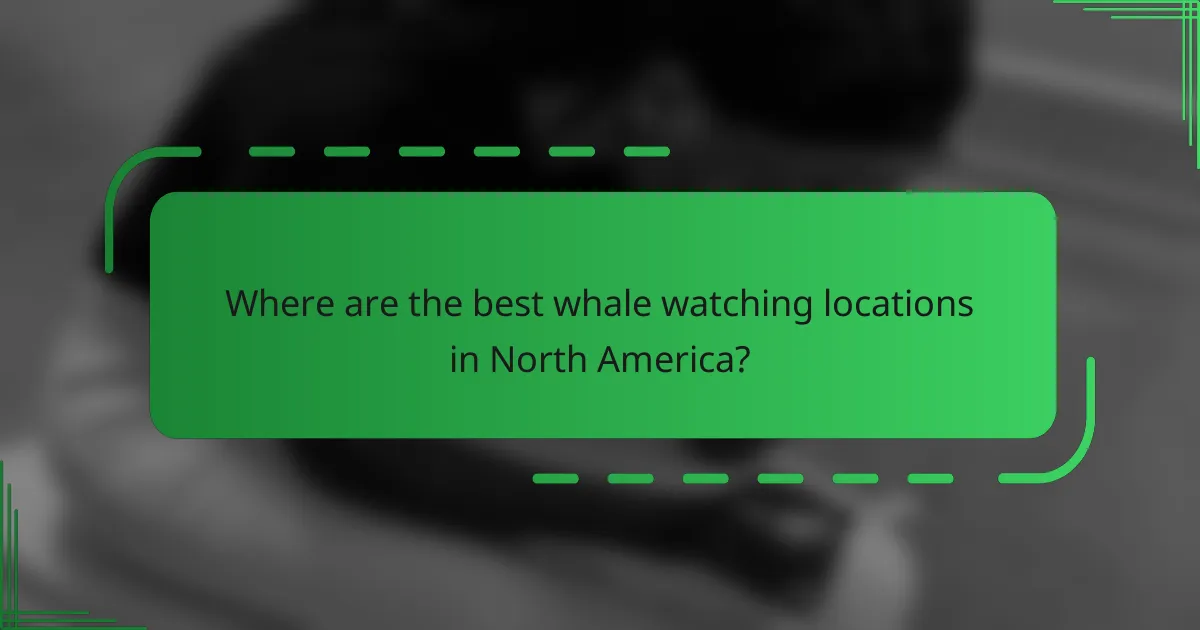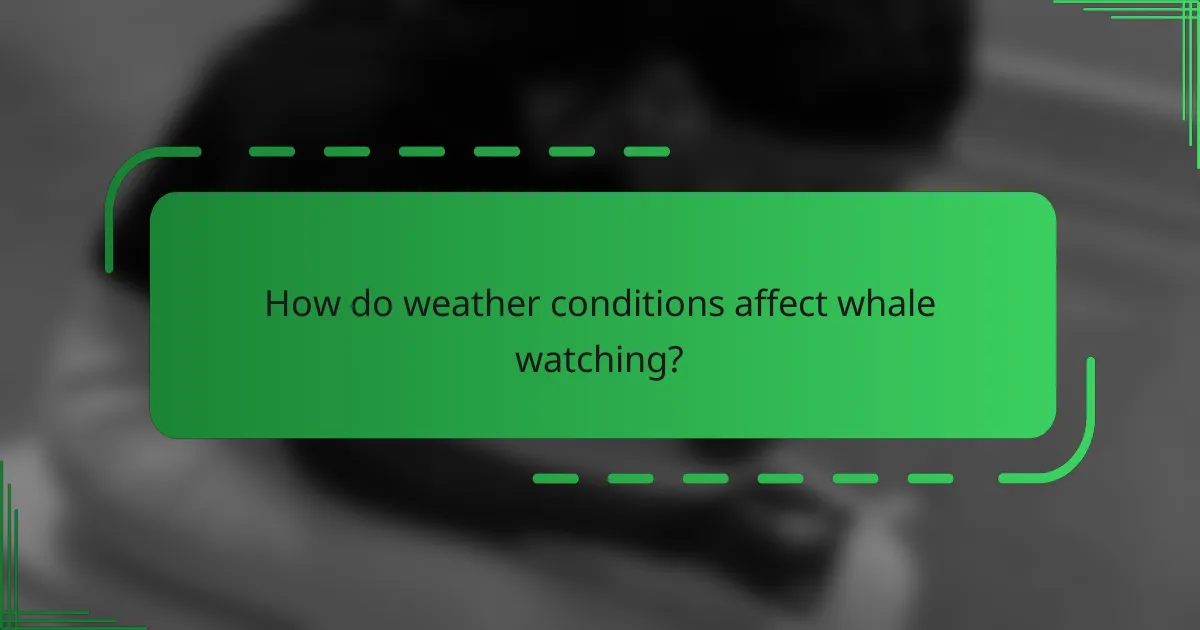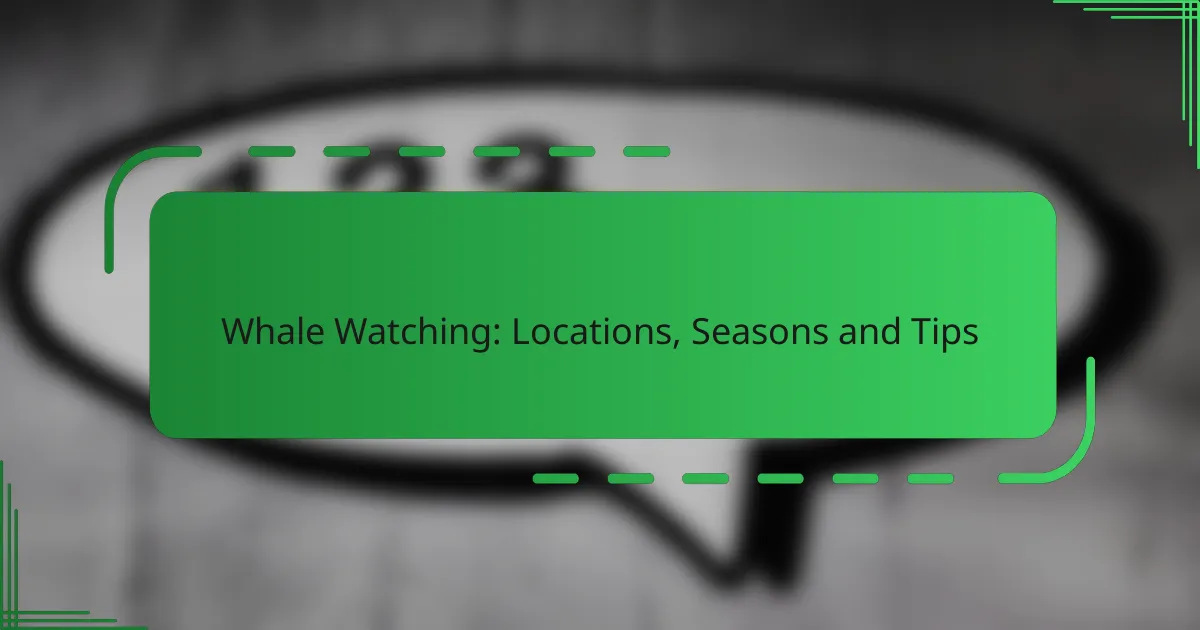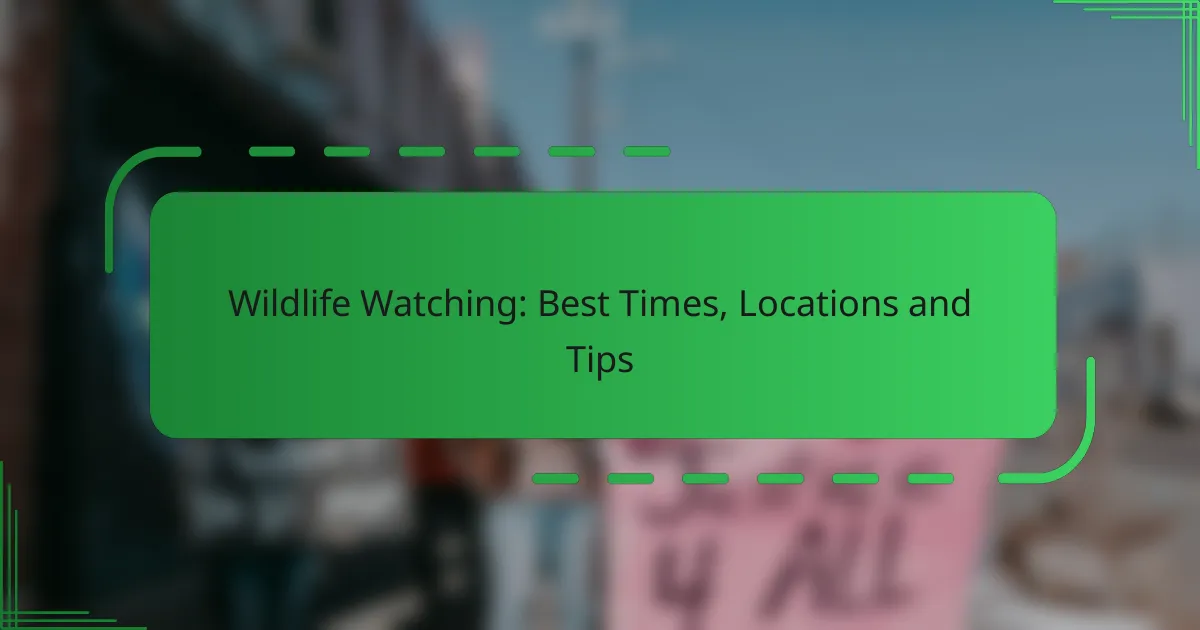Whale watching is an exhilarating experience that allows you to observe these majestic creatures in their natural habitats. With prime locations across North America, such as California, Hawaii, and Alaska, each region offers unique seasons and species to encounter. To make the most of your adventure, it’s essential to choose reputable tour operators, prepare for the weather, and remain patient and quiet during your outing.

Where are the best whale watching locations in North America?
The best whale watching locations in North America offer diverse opportunities to see various species in their natural habitats. Popular spots include California, Hawaii, Alaska, Washington, and Oregon, each with unique seasons and species to observe.
Monterey Bay, California
Monterey Bay is renowned for its rich marine life, making it a prime spot for whale watching. Visitors can see humpback whales, gray whales, and blue whales, especially from late spring to early fall.
When planning a trip, consider taking a guided boat tour for the best chances of sightings. Tours typically last 2-3 hours and often provide educational insights about the whales and their environment.
Humpback Whale National Marine Sanctuary, Hawaii
This sanctuary is a critical habitat for humpback whales, particularly during their breeding season from December to April. Visitors can witness these majestic creatures breaching and singing in the warm Hawaiian waters.
To enhance your experience, choose a tour that emphasizes responsible whale watching practices, ensuring minimal disturbance to the whales. Many local operators offer eco-friendly options that educate guests about marine conservation.
Prince William Sound, Alaska
Prince William Sound is famous for its stunning landscapes and abundant wildlife, including orcas and humpback whales. The best time for whale watching here is during the summer months, when the waters are teeming with food for the whales.
Consider a multi-day cruise to fully appreciate the area’s beauty and increase your chances of sightings. Be prepared for variable weather conditions and dress in layers to stay comfortable.
San Juan Islands, Washington
The San Juan Islands are a top destination for orca whale watching, particularly from May to October. The waters around the islands are home to resident pods of orcas, making sightings quite common during this period.
Opt for a small group tour for a more personalized experience, and be sure to bring binoculars for better viewing. Respect local regulations regarding distance from the whales to ensure their safety and well-being.
Newport, Oregon
Newport is an excellent location for spotting gray whales, especially during their migration from December to June. The coastal views are breathtaking, providing a scenic backdrop for whale watching.
Check local tour schedules, as many operators offer seasonal trips that coincide with peak migration times. Bring a camera to capture the moments, and remember to dress warmly, as ocean breezes can be chilly.

What seasons are ideal for whale watching?
The best seasons for whale watching vary by species and location, with each season offering unique opportunities to observe different whales. Understanding these seasonal patterns can enhance your chances of a successful whale watching experience.
Winter for Gray Whales
Winter is the prime season for spotting gray whales as they migrate from their feeding grounds in the Arctic to warmer breeding waters off the coast of Mexico. This migration typically occurs from December to April, making it an ideal time for whale watchers along the Pacific Coast.
During this season, whale watching tours are abundant, particularly in California. Look for tours that operate from San Diego to Monterey, where sightings of gray whales are common.
Spring for Humpback Whales
Spring marks the return of humpback whales as they migrate back to their feeding areas after breeding. This season generally spans from March to June, with peak sightings occurring in April and May.
Locations such as Hawaii and Alaska are popular for observing humpbacks during this time. Consider booking a tour that focuses on areas known for their high humpback populations, and remember to check local regulations regarding viewing distances.
Summer for Blue Whales
Summer is the best time to see blue whales, the largest animals on the planet, as they feed in nutrient-rich waters. This season typically runs from June to September, with sightings peaking in July and August.
California’s Channel Islands and the waters off the coast of British Columbia are renowned for blue whale sightings. Ensure you choose a reputable tour operator that follows guidelines for responsible whale watching to protect these majestic creatures.
Fall for Orcas
Fall is the prime season for observing orcas, also known as killer whales, as they are often seen hunting for salmon. This season spans from September to November, with peak activity typically occurring in October.
Regions like the Pacific Northwest, particularly around Washington State and British Columbia, are excellent for orca watching. Look for tours that specialize in orca sightings and adhere to local wildlife viewing regulations to minimize disturbance to these social animals.

What tips enhance the whale watching experience?
To enhance your whale watching experience, focus on choosing reputable tour operators, bringing binoculars, dressing appropriately for the weather, and maintaining patience and quietness during the trip. These elements can significantly improve your chances of seeing whales and enjoying the outing.
Choose reputable tour operators
Selecting a reputable tour operator is crucial for a successful whale watching experience. Look for companies with positive reviews, knowledgeable guides, and a commitment to responsible wildlife viewing practices. Many operators follow guidelines to minimize disturbances to marine life, which is essential for both safety and conservation.
Check if the operator is licensed and adheres to local regulations regarding whale watching. This ensures that they follow ethical practices and contribute to the sustainability of whale populations.
Bring binoculars for better viewing
Bringing binoculars can significantly enhance your whale watching experience by allowing you to see distant whales more clearly. A good pair of binoculars with a magnification of 7x to 10x is ideal for spotting whales from a distance without disturbing them.
Consider using binoculars with image stabilization features to reduce blurriness caused by boat movement. This will help you enjoy the sight of whales breaching or spouting from afar, making the experience more memorable.
Dress in layers for changing weather
Weather conditions can change rapidly on the water, so dressing in layers is essential for comfort during whale watching. Start with a moisture-wicking base layer, add an insulating layer, and finish with a waterproof outer layer to protect against wind and splashes.
Be sure to wear sturdy shoes and bring a hat and sunscreen, as sun exposure can be significant even on cloudy days. This preparation will help you stay comfortable and focused on the whales rather than the weather.
Be patient and quiet
Patience and quietness are vital for a successful whale watching trip. Whales are wild animals, and sightings can be unpredictable. Staying calm and quiet increases your chances of spotting them, as loud noises can scare them away.
Take your time to observe the surroundings and listen for sounds like spouts or breaches. Engaging in quiet conversations with fellow passengers can also enhance the experience without disturbing the wildlife.

What factors should you consider when selecting a whale watching tour?
When selecting a whale watching tour, consider factors such as tour duration, group size, and the expertise of the guides. These elements can significantly impact your overall experience and the likelihood of spotting whales.
Tour duration and distance
The duration of a whale watching tour typically ranges from a few hours to a full day. Shorter tours may cover less distance, limiting your chances of encountering whales, while longer tours often venture further into the ocean, increasing opportunities for sightings.
Consider your comfort level and schedule when choosing a tour length. If you’re prone to seasickness, a shorter trip might be more enjoyable, while those eager for a comprehensive experience may prefer a longer excursion.
Group size and boat type
Group size can greatly affect your whale watching experience. Smaller groups often allow for a more personalized experience, with better opportunities for interaction with guides and clearer views of the whales.
The type of boat used also matters. Larger vessels may provide more stability and comfort but can limit your proximity to the whales. In contrast, smaller boats can navigate closer to marine life, enhancing the thrill of the encounter.
Expertise of the guides
The knowledge and experience of the guides are crucial for a successful whale watching tour. Guides with extensive backgrounds in marine biology or ecology can provide valuable insights into whale behavior and the local ecosystem.
Look for tours that emphasize the qualifications of their guides. Reading reviews or asking about the guides’ experience can help ensure you choose a tour that offers informative and engaging commentary throughout your trip.

How do weather conditions affect whale watching?
Weather conditions significantly influence whale watching experiences by impacting visibility, sea conditions, and whale behavior. Factors such as wind, precipitation, and sea state can either enhance or hinder the chances of spotting whales.
Calm seas improve visibility
Calm seas are crucial for optimal visibility when whale watching. When the water is smooth, it reduces wave interference, allowing for clearer sightlines to spot whales surfacing for air. This is especially important in regions known for rough waters, where choppy conditions can obscure views.
In addition to visibility, calm seas often lead to a more comfortable experience on the boat. Tourists are less likely to experience seasickness, which can detract from the enjoyment of the outing. Aim for days with low wind speeds and minimal wave height for the best chances of spotting whales.
Check local weather forecasts and marine reports before planning your trip. Ideal conditions typically include wind speeds below 10 knots and wave heights under one meter. This information can help you choose the best time for your whale watching adventure.



